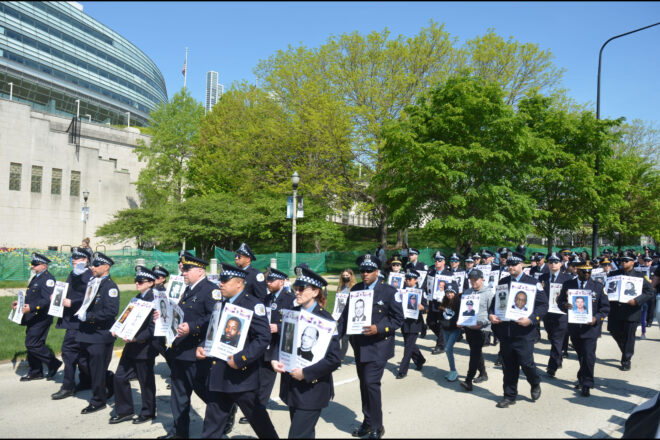The greatest warning that Secure 1776 can associate with a community is that it is becoming a “Hadleyville.” What is a “Hadleyville?” Thomas Lemmer was the first to speak about Hadleyvilles in his 2015 article “It’s High Noon for American Policing.” Is Chicago a Hadleyville? To begin to answer this question, let’s consider three recent articles on policing and crime in Chicago.
First, an article published today, 26 July 2021, by the Chicago Sun-Times. The article is entitled, “73 people hit by gunfire in Chicago over the weekend. At least 11 died, including 17-year-old.” Summer weekend violence is the regular subject of reporting by Chicago’s news media.
Second, a column from Michael Sneed, “Chicago police officers caught in roiling mess of fear, shock, anger — and hesitation.” This column was published on 23 July 2021 in the Chicago Sun-Times. The column provides key insights from confidential sources. [Editor’s note: neither Secure 1776 nor Thomas Lemmer were contributors to the Sneed column.]
Third, an article from Patrick Smith, “Chicago Police Describe ‘Total Burnout’ After Canceled Days Off And 12-Hour Shifts.” The Smith article was published by WBEZ (an NPR affiliate) on 19 July 2021. Smith provides both on-the-record statements from Chicago Police Department (CPD) officials and unnamed observations from CPD personnel.
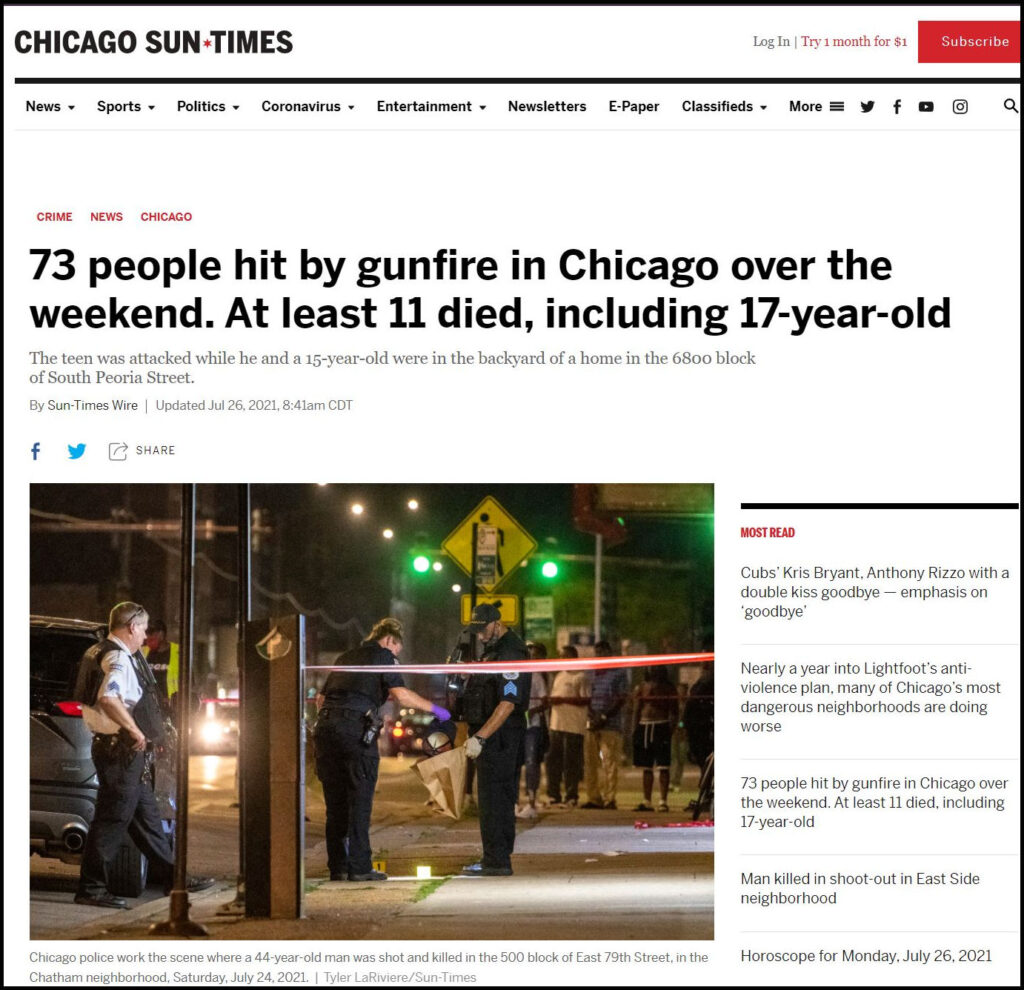
Monday Morning Reporting in Chicago
Today being a summer Monday in Chicago, there were local news items summarizing the city’s weekend violence.
As a rule, the Monday articles include a listing of shootings, with particular focus on any incidents that involve children. Secondly, as a rule, these Monday articles provide a year-to-date murder count for the city. There is only one exception to this summer Monday morning reporting by Chicago’s news media. When it’s a holiday Monday weekend, these articles come out on Tuesday morning.
Here are the big-picture takeaways from the Chicago Sun-Times weekend violence article for today, Monday, 26 July 2021:
— “People were shot in all but four of the city’s 22 police districts. More than half the victims were attacked in the Austin and Harrison police districts on the West Side and the Gresham and Englewood districts on the South Side.“
— “Those districts cover some of the deadliest neighborhoods in Chicago, according to Sun-Times data (they include): Austin, Englewood, East Garfield Park, Auburn-Gresham, West Garfield Park and Humboldt Park.”
— “The city has recorded at least 426 homicides this year, down 1% from 432 homicides last year at this time, but up 48 percent from 289 two years ago.”
— “Sixty people were shot, 10 fatally, last weekend in Chicago.”
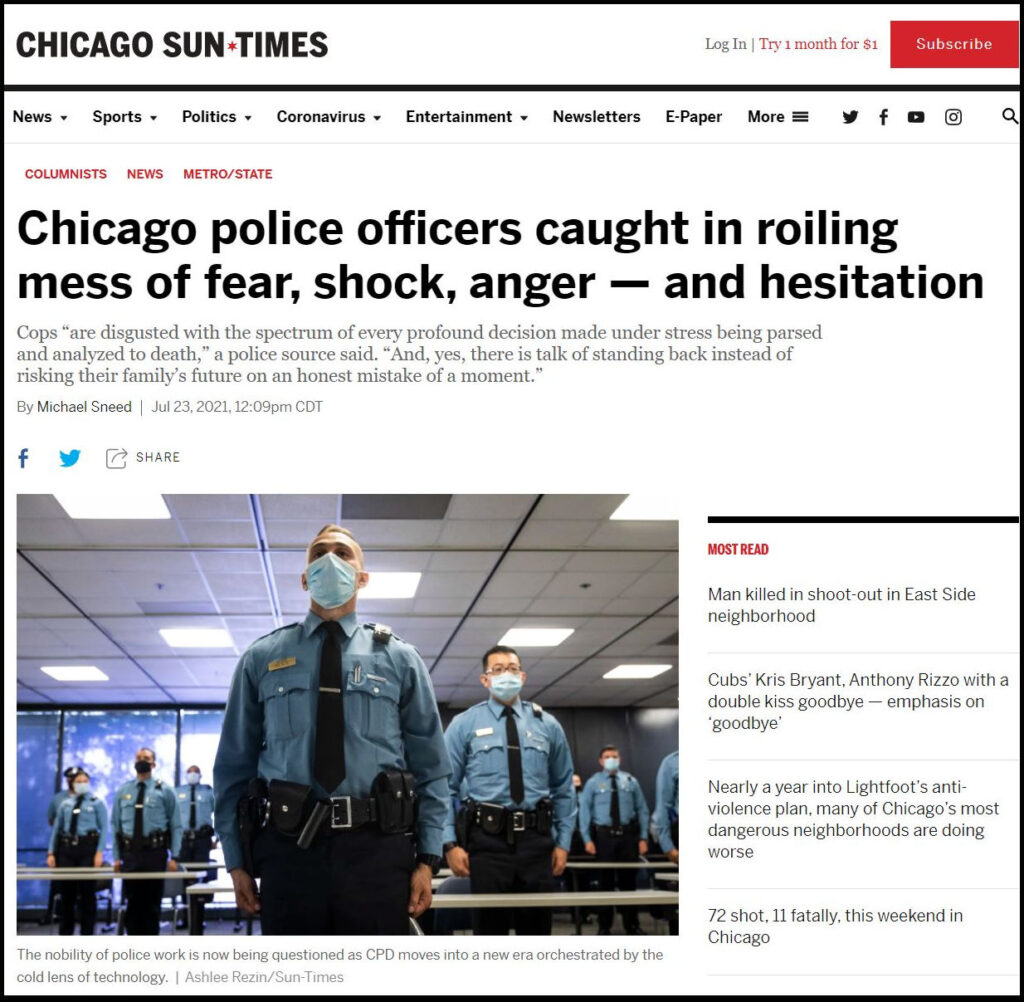
Observations from the Sneed Column
In the online version of the column, below the title and above the byline, there is a powerful introduction that reads:
— “Cops ‘are disgusted with the spectrum of every profound decision made under stress being parsed and analyzed to death,’ a police source said. ‘And, yes, there is talk of standing back instead of risking their family’s future on an honest mistake of a moment.’”
Sneed takes note that police officers in Chicago are “caught in the roiling mess of fear, shock, anger, and, God help us … hesitation.”
She added: “Meanwhile, Chicagoans are recalibrating what it means to go to work, to walk the streets or park a car because of a spike in crime. Cops are rethinking how to do their jobs.”
We salute Sneed for recognizing the danger to a community that follows when police officers are hesitant to act.
The following additional points from Sneed standout to us. Quoting from the column:
–– “’The cops are being held accountable, probably to 15 agencies, but nobody seems to be calling the politicians to be held accountable … or anyone in this s- – -storm,’ the source added.”
— “’Now … nobody respects or fears cops if they know the police are handcuffed.'”
— “’I’ve been in a car with cops recently when kids stop next to us, then look at us, and then drive through a red light totally passive and unresponsive. And they look both ways before they go through. It’s a message. A very scary one.'”
— “Recordings of profound decisions made under stress are now being picked over by attorneys, the news media and politicians. ‘Would a surgeon permit that, or a therapist, or emergency room hospital staff? The police are the cutting edge of that razor, the tip of that spear,’ said (a) former police counselor.”
On the comparison to other professions, we encourage Sneed and Secure 1776 followers to read Thomas Lemmer’s article published in the June issue of the National FOP Journal. Entitled, “Tragedy-free Policing, or Else – A Need for Critical Thinking,” the article dramatically highlights how policing is held to a standard we all know is unworkable, if we are using the medical profession as a model.
In the second to last line of the column, Sneed asks: “Is the city going to get the police department it deserves?”
Such is the $64,000 question (older readers will get this reference). Indeed, will Chicago and our cities and towns across the country get the police departments they deserve. What does that outcome look like? In the last line of her column, Sneed wrote: “Let’s hope so.” Apparently she did not have the benefit of the “Hadleyville” lesson when she wrote the column. Let us hope for Chicago that the city’s elected officials, civic leaders, news media, and residents rise to the demands that come from their own roles within the current urgent challenge. How will they work to strengthen, and not further weaken, the city’s already damaged police-community relationship? Only then can we safely conclude that the “police department we deserve” will be a positive outcome.
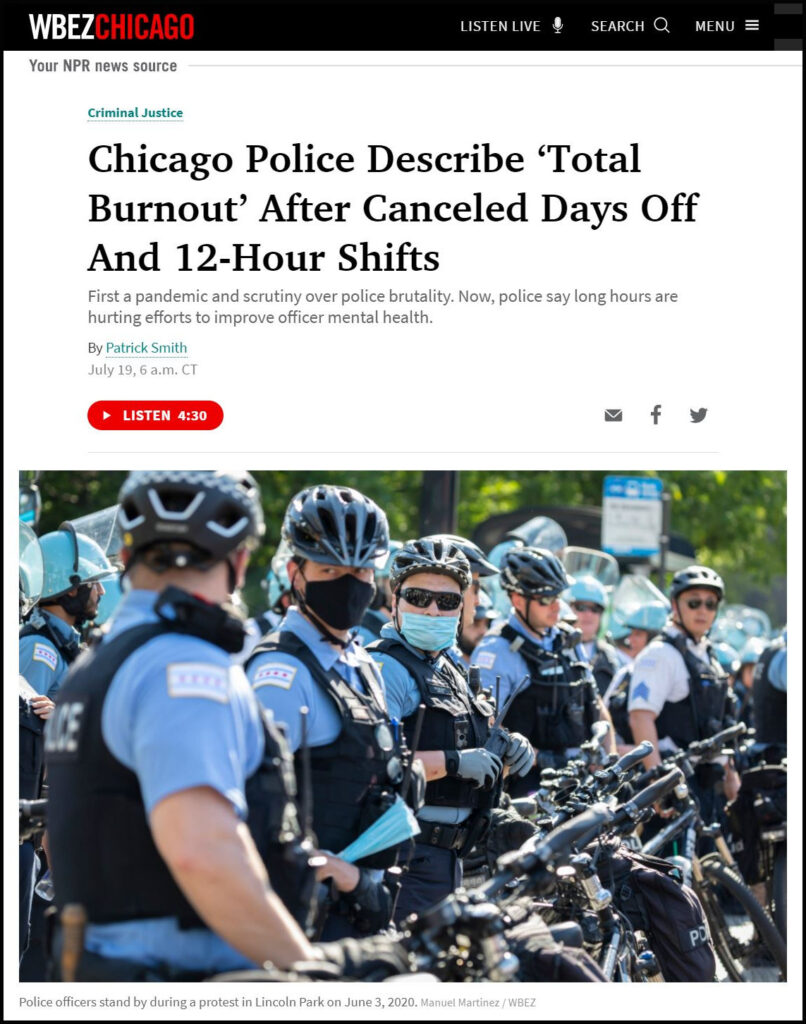
Observations from the Smith Article
The opening of the Smith article on policing in Chicago reads as follows: “For the past year, as violent crime has spiked in Chicago, the Police Department has been regularly canceling officers’ days off, mandating 12-hour days and sending police officers to neighborhoods they’ve never policed before.”
As referenced in Smith’s article, CPD Superintendent David Brown has said that “officer wellness is one of the ‘five pillars’ of transforming CPD.” However, relative to the current state of policing in Chicago, Smith wrote: “Nearly every officer interviewed by WBEZ said morale at the department is worse than they’ve ever seen it.” Smith added, “… officers say the long hours and canceled days off completely undermine any message of wellness.”
Among the sources interviewed by Smith was Alexa James, the CEO of the Chicago chapter of the National Alliance on Mental Illness (NAMI) and the senior adviser on officer wellness to Superintendent Brown. James is quoted extensively in the article. We offer the following remarks of particular note from James:
— “As a social worker, James said, she never feels like she’s being held responsible for the mistakes or the abuses of other social workers. But she said that is how cops on the beat are feeling, like everyone is judging them based on a few bad actors.”
— “There is something that we have to pay attention to around what it feels like for us to be grouping the police so broadly, and what it feels like for officers who are doing this good work, to have so many people monitoring them,” James said. “And I’m not saying that there shouldn’t be accountability at all. I’m saying ‘let’s think about what it feels like.’ And I think that that conversation is missing a lot from the police reform conversation.”
— “James said in her time working within CPD she’s gained an appreciation for the ‘tremendous’ resilience from officers. ‘And this real commitment to get up and keep going,’ she added. ‘Where I think under the circumstances, you would see a lot of people in any occupation just be done.’”
However, the resilience of CPD’s officers is being strained. Among the line personnel quoted by Smith was an unnamed 16-year-CPD veteran. When asked to “rank morale on a scale of 1-10, she said, ‘Can I use negative numbers, like negative 500? Because that’s my answer.’”
Another officer commented on the rise of “much more brazen” offenders. Quoting: “‘It’s almost like they’ve been trained by the media, and by the general public and even elected officials to a large part, because police are portrayed so negatively.’”
Among the key takeaways from Smith’s article: “there is no question officers are feeling an increased level of scrutiny. They fear being railroaded if they make a mistake or do the wrong thing in the field. And they say reforms and policy changes have taken away some tools needed to do their jobs effectively.”
Additionally, a lack of confidence in city officials was evident in the remarks of yet another officer. This 28-year veteran when asked about the city’s mayor and some aldermen spoke of his sense that officers did not have their support. This officer was quoted as believing these elected officials are saying to Chicago’s police officers: “‘We don’t like you. We want to defund you. We want to give you the worst equipment. But yet still, you got to jump into what we say when we feel like it and you have no choice in the matter.’”
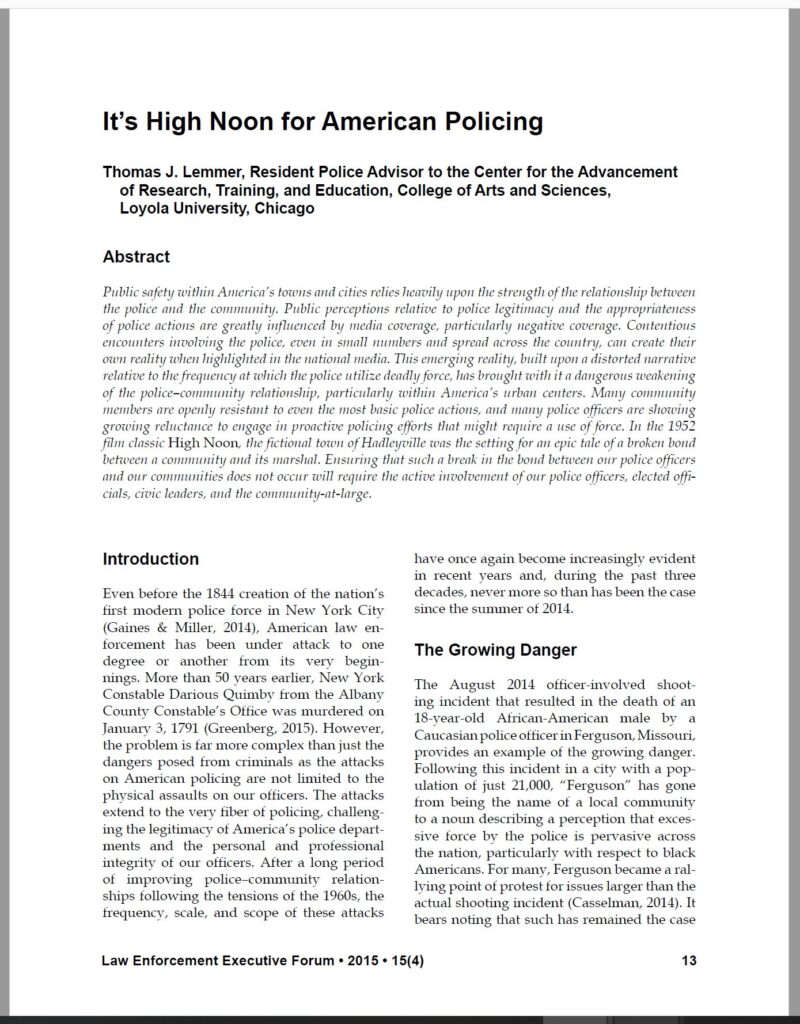
Hadleyville and the Police-Community Relationship
What is a “Hadleyville?” Hadleyville was the fictional western town that served as the setting for the classic 1952 film “High Noon.” There the bond between a town and its marshal was broken. Early in the film we learn that a pardoned killer is arriving on the noon train. Together with his gang, the killer is intent on seeking his revenge in Hadleyville. Yet, even knowing the coming danger, the town’s leaders and people refuse to come to the marshal’s aid. Despite all of his prior work on behalf of the town, the marshal is left without community support as he confronts the threat to public safety and the coming violence.
Is Chicago a Hadleyville? There are clear warning signs that the city is at risk of so damaging its police-community relationship that it may be sliding into a long period of lawlessness. Public safety has already suffered, and violence is already taking the lives of Chicagoans at an alarming frequency. Perhaps as a society we could benefit from watching a few more old westerns. Film dramas showing gangs of gunmen riding into a community, to do as they please, would provide us a timely and real-life lesson. We are beginning to see what everyday life looks like when outlaws are unconcerned about legal consequences. Learning these lessons from film (and our own history) would be a far better approach.
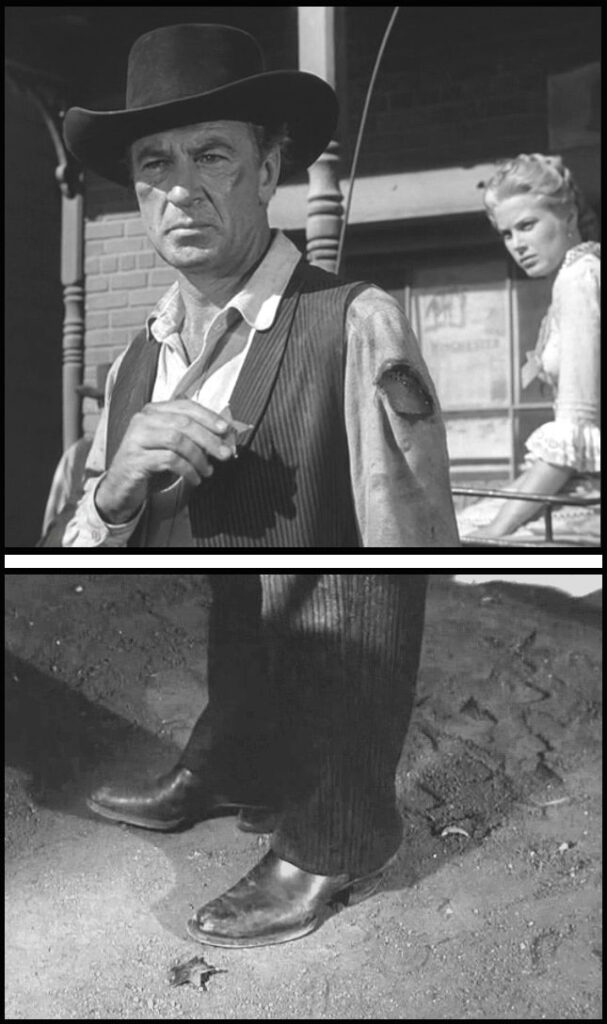
In the final scene of High Noon, the break in the police-community bond in Hadleyville reaches it conclusion. Quoting from Lemmer’s “High Noon for American Policing:”
— “Yet as high noon arrived on Marshal Kane’s wedding day – his final day wearing a star – he found himself alone. The rhythmic tick of the clock, the wail of the train whistle, and the emptiness of the streets all foreshadowing the coming conflict, as now four gunmen were making their way toward the center of Hadleyville intent on murdering the marshal. Gunfire erupts, the struggle commenced, and it was cruelly evident that the sacred bond he once shared with his town had then and there been broken beyond redemption. It is a scene that must be watched to be fully appreciated and witnessed. The shooting ended – the bond destroyed – one symbolic moment remained for Will Kane and the town. As the marshal unpins his star, he holds it for a moment, recalls its importance and the bond it represented, and then he casts the star into the dust of the street. Who would want to wear that or any star in Hadleyville? Who would want to live there?”
A Message for Chicago and Other Cities and Towns
In his 2015 “High Noon” article, Lemmer asked the reader to consider how will it end for us where we live. He provided the following warning:
— “If the most strident and contentious of our society are allowed to sever the bonds between our communities and our police officers, no matter the name of our city or town, we will all be living in a Hadleyville. The responsibility to prevent this end rests with all of us. We must not allow indifference, fear, or anger to break the sacred bond between our officers and our communities. If we fail to do so … all the sacrifices of our police officers will have been for nothing, and in that wake evil will triumph.”
Lemmer had also provided signs of hope and a way forward for places like Chicago and the nation. We strongly encourage Secure 1776 followers to read “It’s High Noon for American Policing” in its entirety. The officers of the Chicago Police Department, as do police officers across the country, have much to be proud of, as they continue to wear their stars and badges. As noted in our posting on New York transit safety, our civic leaders and elected officials across America must “step up” as well.
[Note: Following the murder of Chicago Police Officer Ella French, and the wounding of her partner, we provided an update to this post.]
We are interested in your thoughts, and invite you to comment below.

Copyright Protected | (c) 2021 Secure1776.us – All rights reserved.

